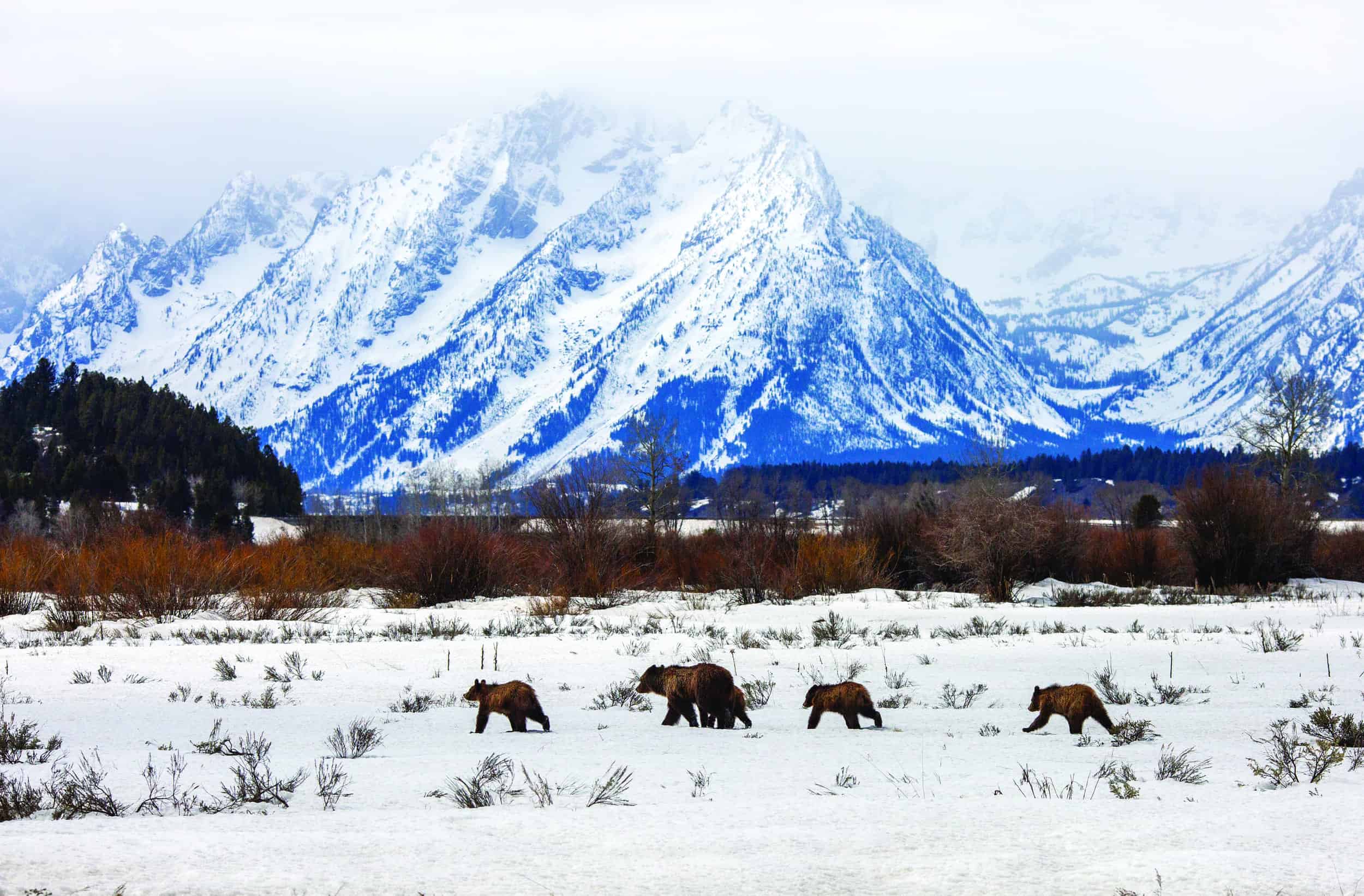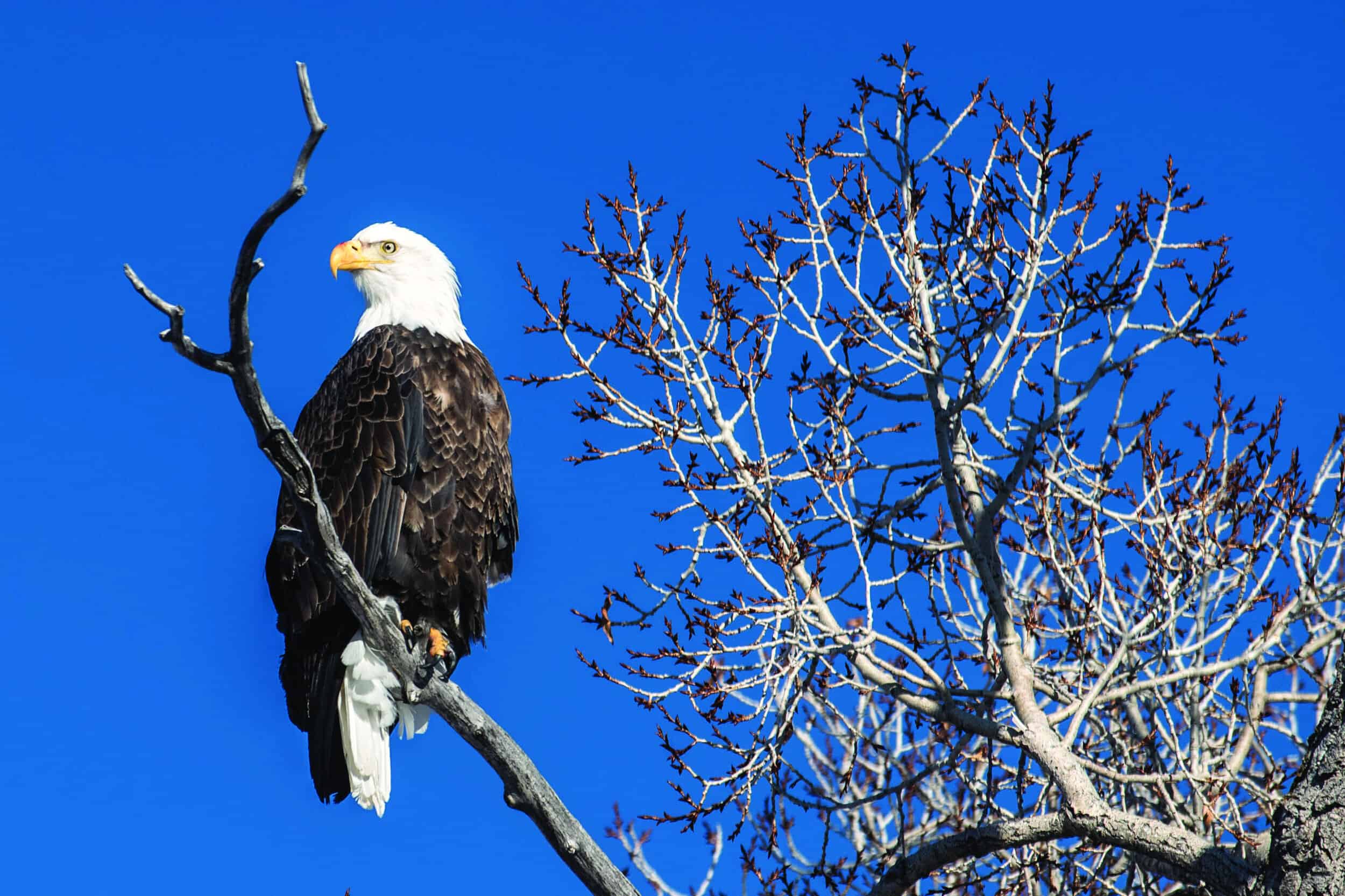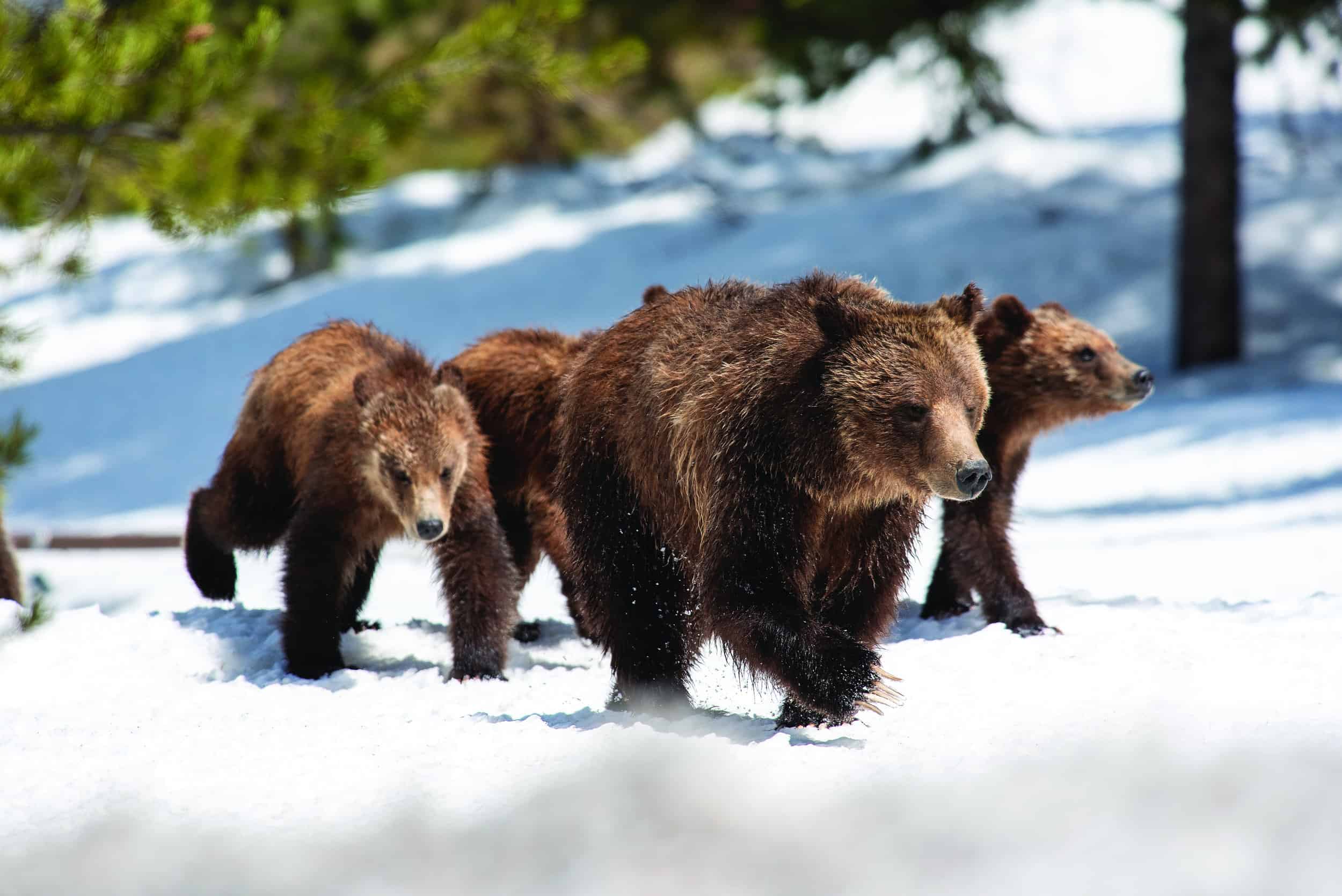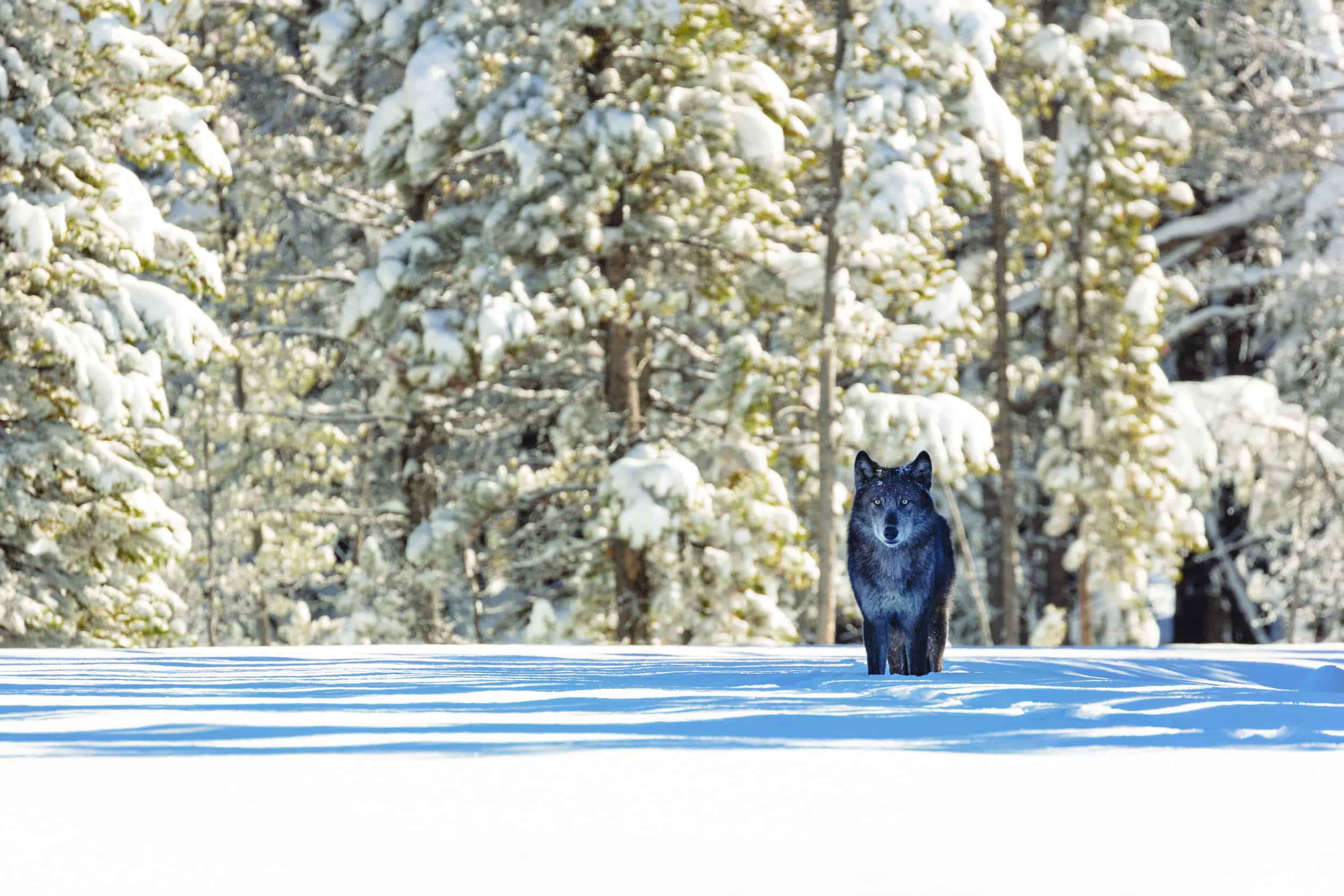Read The
Current Issue
Endangered No More
The year 2023 marks the 50th anniversary of the Endangered Species Act, a landmark law that made the Greater Yellowstone Ecosystem whole.
// By Mike Koshmrl

In the fall of 1983, Brian Czech was an early-career U.S. Forest Service ranger patrolling his favorite place of all time, the Teton Wilderness, when he saw something he’d never seen before: a grizzly bear.
The bruin was treading through six inches of fresh-fallen powder in the backcountry at Fox Park, a remote mountain meadow a mile south of the Yellowstone National Park border and eight miles west of the Continental Divide. Czech, then in his early twenties, wanted a closer look at this grizzled ursine emblem of the wild. Atop his mount, a Tennessee walker named Diamond, he inched nearer. By the time he got within 56 yards—a distance he paced off the next day—the big bear decided it wasn’t too fond of its human-on-horse fan club. “He went up on his hind legs and sniffed at the air for two or three seconds,” Czech recalls. “It’s a long time ago, but something like that you remember.” The grizzly plopped back down to all fours. Then it put one foot in front of the other. Then the motion picked up speed. “He was pumping, straight at me,” Czech says. “I didn’t have to do a damn thing, I just had to stay on my horse, Diamond. He immediately wheeled toward the ranger cabin.”
At the time, Czech made light of the grizzly run-in with an observation: he was the only person he knew who’d been charged by the only grizzly bear they’d ever seen. And despite spending two more 1980s summers in the 585,000-acre Teton Wilderness, including one season mapping grizzly bear habitat, Czech never saw another grizzly there. (A decade later, he saw plenty of grizzlies while working in Alaska.) At the time, the great bears were still in the early stages of a decades-long recovery in the Greater Yellowstone Ecosystem. Wolves, which were extirpated from the ecosystem by the 1930s, hadn’t yet been reintroduced. Another now-common emblem of the wild, bald eagles, were also seldom seen, though their population was gaining steam. The Endangered Species Act, 50 years old in 2023, changed the fates of all of these species. Today, grizzlies can be expected at Fox Park; the Teton Wilderness is now known for its dense population of the species. Wolves are equally back at home in the GYE—many hundreds live in the area today (more than 3,000 live across the American West). Bald eagles in Jackson Hole and beyond are basically ubiquitous.
Grizzlies, wolves, and bald eagles are among the more charismatic species that owe their lives to the ESA, but they’ve got good company. Noah Greenwald, endangered species director for the Center for Biological Diversity, estimates that the ESA has prevented the extinction of 291 species since its passage in 1973. “It’s a tremendous law that set a precedent for the rest of the world,” he says. “These were animals that the federal government actively worked to eliminate around the country. It turned the tide; these animals went from being annihilated to protected because of the Endangered Species Act.”
“It’s a tremendous law that set a precedent for the rest of the world. These were animals that the federal government actively worked to eliminate around the country. It turned the tide; these animals went from being annihilated to protected because of the Endangered Species Act.”
—Noah Greenwald, endangered species director for the Center for Biological Diversity
Czech, after woodsmen days in Wyoming and beyond, turned to academia, and he got to know the Act well. Now a Virginia resident, he conducted a policy analysis of the ESA for his PhD at the University of Arizona, and his dissertation was later adapted into a book, The Endangered Species Act: History, Conservation, Biology and Public Policy. By forcing humans to slow down their activities instead of overrunning imperiled species, the ESA, Czech argues, acts as a prescription for a steady economy. “There’s a fundamental conflict between economic growth and species conservation,” he says. “The economy is pushing out species left and right, and it’s pressuring species left and right. If the economy continues growing and growing and growing, it will extinguish those species left and right.” In other words, a byproduct of the ESA is that it slows down growth by making us account for our impacts on the creatures we share the Earth with. History has proven that, without laws forcing our hand, humankind does a poor job of conserving other species for their own sake. Many North American species, like the passenger pigeon, were lost before the ESA came about. Bison were nearly among those extinctions. Other animals, like the San Marcos gambusia minnow and a host of Hawaiian songbirds and freshwater mussels, were listed in the Act but went extinct anyway.
The first wildlife-protection law in the United States can be traced to northwest Wyoming: The Lacey Act of 1884, also known as the Yellowstone Game Protection Act. Inspired by public outrage after poacher Ed Howell got off light for being caught with dead bison in the park’s Pelican Valley—poaching was against park regulations, but it was not illegal—the Lacey Act added legal teeth to the prohibition on park hunting. Six years later it was broadened into the nationwide Lacey Act, still in effect today. There were also two direct precursor laws to the ESA of 1973. The Endangered Species Preservation Act of 1966 had the goal of addressing potential extinctions of species like the whooping crane and bald eagle. Three years later, the Endangered Species Conservation Act of 1969 broadened its predecessor’s parameters by including species and subspecies threatened with worldwide extinction and prohibited the importation of these species into the U.S. from any foreign country.
There were several major changes from the 1960s acts to the 1973 ESA that gave it more regulatory reach and teeth. “One, there was a recognition that habitat was a driver of extinction,” Greenwald says. “And it added species—plants—recognizing that plants are foundational to life on Earth.” The final product was a powerful tool to protect not just individual species, but the places where they lived. It was comprehensive, procedural, and a one-stop shop for protecting species of any kind. “And it goes well beyond species,” Greenwald says. “The language about ecosystems upon which species depend is really strong.”
The ESA had broad bipartisan support in its early years, but it didn’t last. The first big fight came during construction of the Tellico Dam on the Little Tennessee River, an impoundment that threatened the existence of a two- to four-inch-long minnow called the snail darter (the minnow lives on, but only because it was moved to other river systems before the dam was finished in 1979). Today, the ESA garners little political support in conservative places like Wyoming, where threatened and endangered species—the act’s two major classifications—exist on the landscape and must be accounted for, whether it’s the grizzly bear, lynx, or the blackfooted ferret. Partly, that’s explained by Czech’s premise that the ESA inherently slows down the economy. One example is the saga of the sage-grouse, the population of which has been in decline since western settlers started plowing up sagebrush in the homestead era. In the years leading up to 2015, to prevent the species being listed as threatened, which could have curtailed industrial activity like oil and gas drilling in sage-grouse habitat, western states coalesced to conserve the chicken-sized bird by developing state-level plans. This effort was successful for the states, and it persuaded the U.S. Fish and Wildlife Service to not list the species. Still, sage-grouse struggles persist. U.S. Geological Survey research estimates that populations have fallen by 80 percent since 1965—with half that decline occurring in the last 20 years. As few as 200,000 birds remain, down from presettlement estimates of 16 million.
The ESA’s reputation as a tool for never-ending litigation has also won few fans in the West. Grizzlies and wolves, for example, can be difficult species for residents to live with, and both remained protected under the act for years after their populations grew past recovery goals because of one lawsuit after the next. The Center of Biological Diversity—Greenwald’s employer—is often in the thick of that litigation. About the Center for Biological Diversity, Czech says, “It’s hard to know if they’ve been productive in the long run or not, because they certainly have pushed the envelope hard. But I feel like they have been helpful.” Wyoming’s congressional delegation would say the opposite. U.S. senators John Barrasso and Cynthia Lummis and former U.S. Rep. Liz Cheney have all supported failed Endangered Species Act reforms that blunt its regulatory teeth and increase state involvement in administering the longstanding law. “Species that go on the endangered species list seem to stay there forever,” Barrasso said in support of a 2021 ESA-reform bill. A co-signer on that bill, U.S. Sen. Jeff Risch of Idaho, called the ESA “well-intentioned but grossly flawed. More often than not, the law creates so much bureaucratic red tape that it comes at the expense of the very species it seeks to protect,” he said.
Still, ESA supporters see its golden anniversary as cause for celebrating arguably the world’s strongest law for protecting animals and plants from extinction. “Despite the opposition, despite substantial problems with implementation, despite lack of funding, it’s been tremendously successful,” Greenwald says. “Millions of acres across the country have been protected largely because of the ESA. And there’ve been plenty of notable success stories: great whales, grizzly bears, wolves, and many, many others.” Here are snapshots of three of those species’ success stories.

Bald Eagles : An incredible Recovery
The United States of America nearly wiped its literal animal symbol—the bald eagle—off the map. There were many causes of the decline, including indiscriminate killing of all raptors during the settlement era, but by the mid-20th century, the foremost driver was the widespread application of DDT. The pesticide, which thinned egg shells and caused failed nests, was used to kill insects on cropland, but it also was applied aerially by federal agencies like the U.S. Forest Service to protect timber stands from pine beetles. At the low point, in 1963, there were only 417 nesting bald eagle pairs remaining in the Lower 48. The Greater Yellowstone Ecosystem was a stronghold; even at the bottom, there were about 31 pairs here. “This was considered a significant population at the time,” says Susan Patla, a retired Wyoming Game and Fish Department nongame biologist who monitored eagles in the Snake River watershed for decades. “It was actually producing birds that were dispersing to other places.”
After the 1960s nadir, recovery came slowly. The Migratory Bird Act of 1918 and Bald and Golden Eagle Protection Act of 1940 both protected the species, but DDT remained legal until 1972. A year later, the ESA was enacted, and five years after that, bald eagles were listed as endangered throughout the Lower 48. By 1982, Patla says, the agencies were reporting an estimated 50 to 58 pairs in the Greater Yellowstone Ecosystem and 180 and 210 eagles overall. Soon, recovery was soaring. In 1995 bald eagles were reclassified from endangered to threatened, and in July 2007 they were delisted altogether. When the U.S. Fish and Wildlife Service last conducted a nationwide population estimate in 2020, there were 316,700 total birds and 71,400 occupied eagle nests. “They are considered the most successful example of what the Endangered Species Act can do to save species,” Patla says. Although bald eagles are no longer at risk of extinction, some concerns remain: avian influenza, lead poisoning, energy development, and pesticides and contaminants are all threats high on Patla’s mind. “We still need to keep an eye on human disturbance,” she says.

Grizzly Bears: Back from the Brink
Louisa Willcox completed her master’s degree on grizzly bears from Yale University in the early 1980s, a time when the Yellowstone-region population was reeling and largely confined to the protected national park. The causes of the decline were many: grizzlies were hunted, their core habitat was littered with lethal hazards, and a major food source—Yellowstone’s garbage dumps—was taken away from them cold turkey against the advice of preeminent grizzly biologists Frank and John Craighead. Even after grizzlies were awarded ESA protections in 1975, anxieties were high for nearly a decade. “It was like, ‘Oh my God, we’re going to lose these bears and on our watch,’” Willcox recalls. “We really thought grizzly bears were going down the tubes. They were in imminent risk of extinction, there was absolutely no doubt among the scientists.” Population estimates for the Yellowstone region around the time the slow-reproducing ursines were listed ranged from 136 to 312 bears. “They were in Yellowstone, Glacier, and a couple little teeny populations elsewhere,” Willcox says.
Grizzly recovery was slow and steady. Listing flipped a switch that prohibited hunting, and it implored land managers to take drastic steps to protect Ursus arctos horribilis. At the time of listing and up until the late 1980s, there were hundreds of thousands of domestic sheep being grazed on grizzly habitat in the Targhee and Gallatin National Forests. “They were like candy on legs, and the herders were always armed and often they didn’t speak English,” Willcox says. “Bears would just get killed.” The sheep industry tanked partly on its own, but the national forest supervisors also prioritized grizzlies over their permittees and helped facilitate allotment buyouts. By the turn of the century, federal managers estimated that there were 400 to 600 grizzlies and the population was growing at 4 to 7 percent a year. Today, after a change in counting methodology, there are an estimated 1,000 grizzlies where managers count bears in the ecosystem and an untold number of animals wandering outside the counting area. States have pushed for grizzly delisting repeatedly, a step that USFWS has tried to take twice, in 2007 and again in 2017. The change of jurisdiction would have allowed the first grizzly bear hunts since the species’ 1975 listing, but both times the decisions were overturned in court. Willcox, who worries about the state hunts and the effects of climate change on grizzly food sources, is among those of the mind that the great bears deserve continued protections. “If they’re delisted, all bets are off,” she says. “We could easily be back to where we were in 1975.”

Wolves: The Return
Conservationist activist Renee Askins formed an organization in the 1980s, the Wolf Fund, that had a single goal: the reintroduction of wolves to Yellowstone National Park. “Of course, the single mechanism to achieve that was the Endangered Species Act,” Askins says. A provision within the ESA allows wildlife managers to establish “experimental populations.” The road to reintroduction was long and tortuous. Askins, who former U.S. Interior Secretary Bruce Babbitt once called the “den mother” of wolf reintroduction, began advocating in the late 1970s and moved to Jackson Hole in 1981. Living out of a now-vacant home at the base of Shadow Mountain, she was a dogged advocate who educated resistant residents about the virtues of the native canine carnivore, which had been absent from the landscape for more than 60 years. “My staff called it ‘behind enemy lines lecture tours,’” Askins once told the Jackson Hole News&Guide. “Western agriculture had been in control of the politics of the West for so long that no one thought there was a chance in hell [reintroduction] would ever fly.”
It took nearly two decades of advocacy, but reintroduction did indeed fly. In the winter of 1995, the U.S. Fish and Wildlife Service moved 14 wolves to enclosure pens in Yellowstone National Park (17 more came later, and 35 were also moved to central Idaho wilderness areas, for a total of 66 transported wolves; all of the reintroduced wolves came from populations in Canada). That meant the end of the Wolf Fund’s formal involvement. “The Wolf Fund was created with a sunset clause, that when they open the gates to release wolves, we would swing [shut] our doors,” Askins says. “That’s what we did on March 21, 1995, when the first wolves left their enclosures.”
Wolf recovery and expansion since then has been profound. The U.S. Fish and Wildlife Service’s recovery goal of 450 wolves and 45 breeding pairs in Wyoming, Montana, and Idaho was achieved by the turn of the century. Wolves were delisted legislatively in Montana and Idaho in 2011 and administratively the next year in Wyoming, where state officials afforded the species no protections outside of the Greater Yellowstone Ecosystem. Today, there are more than 3,300 wolves estimated in three northern Rocky Mountain states plus Washington and Oregon. Three packs dwell in California and another pack—migrants from Wyoming—lives in Colorado, where state wildlife managers will conduct their own reintroduction effort by 2024. Although the ESA did its job biologically, persecution of wolves persists. Unregulated killing is authorized in 85 percent of Wyoming, and bounty programs have been established in Montana and Idaho, where the state legislatures have gone over wildlife managers’ heads to mandate heavy hunting and trapping. “This is the same old-fashioned cruelty and hatred and venom that really drove the persecution and the complete elimination of wolves,” Askins says. JH





